| Article ID | Journal | Published Year | Pages | File Type |
|---|---|---|---|---|
| 3075985 | Neurología | 2012 | 8 Pages |
ResumenIntroducciónLa ubicación anatómica del alma humana ha constituido un controvertido motivo de discusión en los ámbitos filosófico, teológico y científico a lo largo de la historia. Una de las hipótesis más conocidas sobre este tema fue propuesta por Descartes, para quien el alma se alojaría en la glándula pineal, órgano cerebral cuya especial localización le permitiría dirigir adecuadamente el funcionamiento del cuerpo humano.DesarrolloEn el presente trabajo, analizaremos las influencias históricas que posibilitaron el modelo cartesiano de relación entre el pensamiento (res cogitans) y la extensión (cuerpo-máquina) y las bases técnicas de su principio de dualismo espíritu-materia. En materia filosófica, Descartes se apoyó en los planteamientos de San Agustín y en materia fisiológica y anatómica adoptó gran parte de las teorías vigentes desde la Antigüedad clásica, fundamentalmente las propuestas de la escuela neumática alejandrina (Herófilo, Erasístrato) en relación con los espíritus animales. Asimismo, también podría conocer las hipótesis de algunos anatomistas coetáneos (Diemerbroeck), que establecían la localización del sensorium commune en la glándula pineal.ConclusionesAunque desde el primer momento las teorías de Descartes tuvieron serios detractores, algunos aspectos de éstas perduraron hasta mediados el siglo xix.
IntroductionThe anatomic seat of the human soul has been a controversial matter of discussion in the philosophical, theological and scientific fields throughout history. One of more known hypotheses on this subject was proposed by Descartes, for whom the soul would host in the pineal gland, a brain body with a special location that would adequately address the functionalism of the human body.DevelopmentIn this work, we discuss the historical influences which made possible the Cartesian model of the relationship between spirit (res cogitans) and body-machine (res extensa) and the technical bases of his dualism doctrine. In philosophical terms, Descartes supported Augustine approaches and in physiological and anatomical terms adopted some theories of the classical Antiquity, essentially the proposals of Alexandrian pneumatic school (Herophilos, Erasistratus) in relation to the animal spirits. Descartes might also have known the hypotheses of some contemporary anatomists (Diemerbroeck) which established the location of sensorium commune in the pineal gland.ConclusionsAlthough Cartesian theories had strong criticism even in his time, some aspects of these postulates remained up to mid 19th century.
